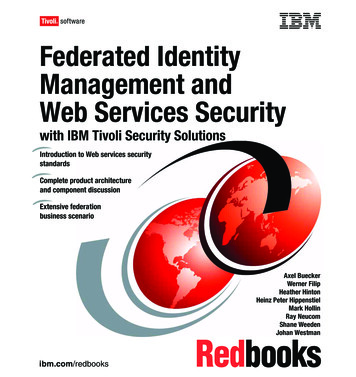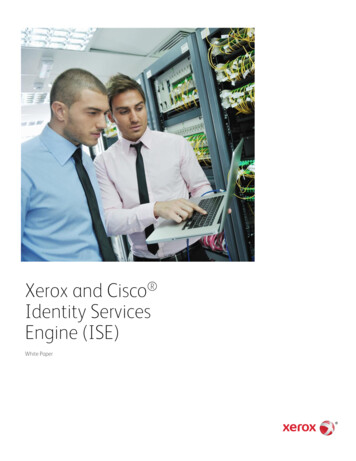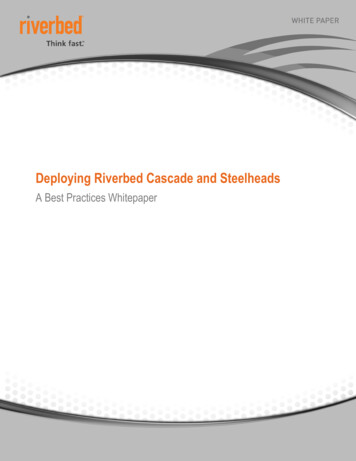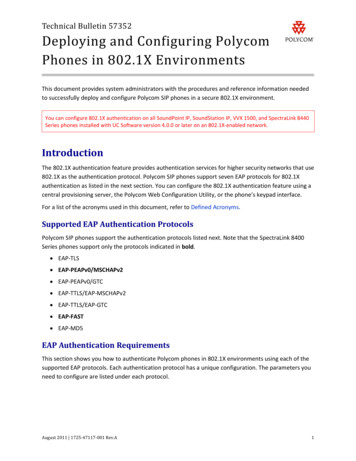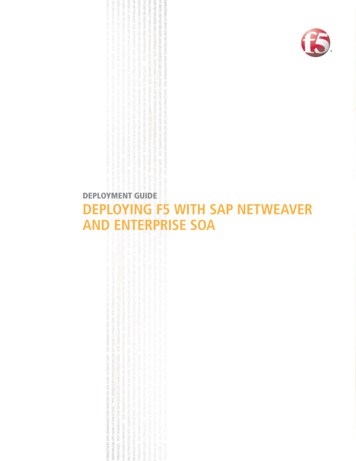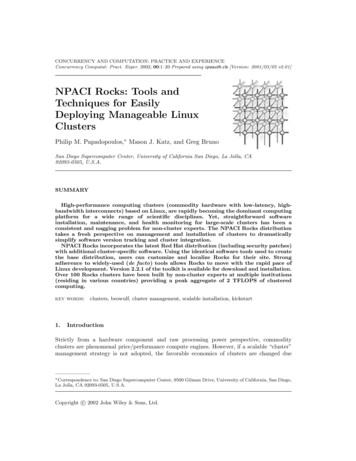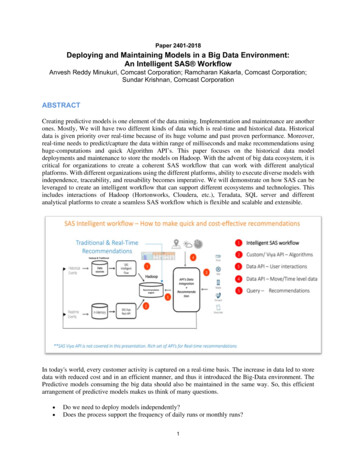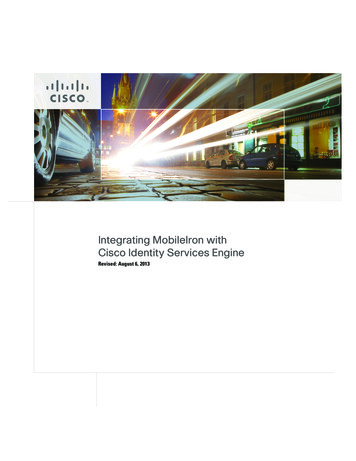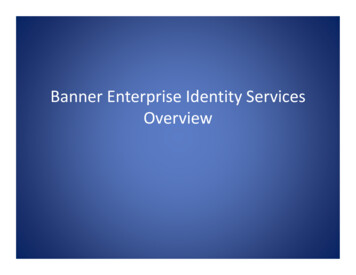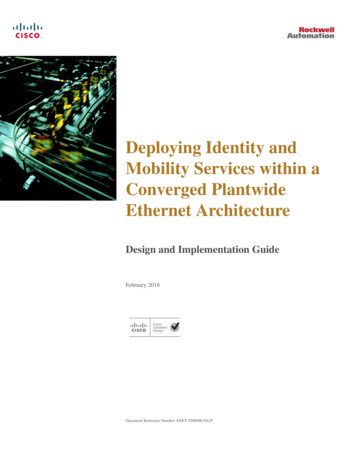
Transcription
Deploying Identity andMobility Services within aConverged PlantwideEthernet ArchitectureDesign and Implementation GuideFebruary 2018Document Reference Number: ENET-TD008B-EN-P
PrefaceConverged Plantwide Ethernet (CPwE) is a collection of tested and validated architectures that are developedby subject matter authorities at Cisco and Rockwell Automation. The testing and validation follow the CiscoValidated Design (CVD) and Cisco Reference Design (CRD) methodologies. The content of CPwE, which isrelevant to both operational technology (OT) and informational technology (IT) disciplines, consists ofdocumented architectures, best practices, guidance and configuration settings to help manufacturers with thedesign and deployment of a scalable, reliable, secure and future-ready plant-wide industrial networkinfrastructure. CPwE can also help manufacturers achieve cost reduction benefits using proven designs thatcan facilitate quicker deployment while helping to minimize risk in deploying new technology.Industrial IoT (IIoT) offers the promise of business benefits through the use of innovative technology such asmobility, collaboration, analytics, and cloud-based services. The challenge for manufacturers is to develop abalanced security stance to take advantage of IIoT innovation while maintaining the integrity of industrialsecurity best practices. Deploying Identity and Mobility Services within a Converged Plantwide EthernetArchitecture CVD (CPwE Identity and Mobility Services), which is documented in this Deploying Identityand Mobility Services within a Converged Plantwide Ethernet Architecture Design and ImplementationGuide (DIG), outlines several security and mobility architecture use cases, with Cisco Identity ServicesEngine (ISE), for designing and deploying mobile devices, with FactoryTalk applications, throughout aplant-wide Industrial Automation and Control System (IACS) network infrastructure. CPwE Identity andMobility Services was tested and validated by Cisco Systems and Rockwell Automation.Document OrganizationThis document contains the following chapters and appendices:ChapterDescriptionChapter 1, “CPwE Identity andMobility Services Overview”Presents introduction to CPwE Identity and Mobility Services architecture, SecureAccess Control, and Unified Network Access Policy Management for CPwE Identity andMobility Services.Chapter 2, “CPwE Identity andMobility Services DesignConsiderations”Presents an overview of CPwE Identity and Mobility Services Technology, wireless andwired access use case overview, design and deployment considerations, and overview ofFactoryTalk mobile IACS applications.Deploying Identity and Mobility Services within a Converged Plantwide Ethernet ArchitectureENET-TD008B-EN-Pii
PrefaceFor More InformationChapterDescriptionChapter 3, “Configuring theInfrastructure”Describes how to configure CPwE Identity and Mobility Services infrastructure based onthe design considerations of the previous chapters, covering the configuration of thewired and wireless network infrastructure, network services, Cisco ISE, and network andapplication security.Chapter 4, “Troubleshooting theInfrastructure”Describes Cisco ISE and wireless infrastructure troubleshooting.Appendix A, “References”List of references for CPwE design and implementation guides for network infrastructureservices and security.Appendix B, “Test Hardware andSoftware”Hardware and software components used in CPwE Identity and Mobility Services testing.Appendix C, “Acronyms andInitialisms”List of acronyms and initialisms used in this document.Appendix D, “About the CiscoValidated Design (CVD) Program”Describes the Cisco Validated Design (CVD) process and the distinction between CVDsand Cisco Reference Designs (CRDs.)For More InformationMore information on CPwE Design and Implementation Guides can be found at the following URLs: Rockwell Automation site:– ? Cisco site:– design-zone-manufacturing/landing ettf.htmlNoteThis release of the CPwE architecture focuses on EtherNet/IP , which uses the ODVA, Inc. CommonIndustrial Protocol (CIP ) and is ready for the Industrial Internet of Things (IIoT). For more information onEtherNet/IP, see the following URL: IP/OverviewDeploying Identity and Mobility Services within a Converged Plantwide Ethernet ArchitectureENET-TD008B-EN-Piii
CHAPTER1CPwE Identity and Mobility ServicesOverviewThis chapter includes the following major topics: Identity and Mobility Services Architecture Introduction, page 1-1 Secure Access Control, page 1-2 Unified Network Access Policy Management for CPwE, page 1-4 CPwE Identity and Mobility Services CVD, page 1-6Identity and Mobility Services Architecture IntroductionThe prevailing trend in Industrial Automation and Control System (IACS) networking is the convergence oftechnology, specifically IACS operational technology (OT) with information technology (IT). ConvergedPlantwide Ethernet (CPwE) helps to enable IACS network technology convergence through the use ofstandard Ethernet, Internet Protocol (IP), network services, security services, and EtherNet/IP. A convergedIACS network technology helps to enable the Industrial Internet of Things (IIoT).IIoT offers the promise of business benefits through the use of innovative technology such as mobility,collaboration, analytics, and cloud-based services. The challenge for manufacturers is to develop a balancedsecurity stance to take advantage of IIoT innovation while maintaining the integrity of industrial security bestpractices. Business practices, corporate standards, security policies and procedures, application requirements,industry security standards, regulatory compliance, risk management policies, and overall tolerance to riskare all key factors in determining the appropriate security stance.As access methods to the plant-wide industrial network expand, the complexity of managing network accesssecurity and controlling unknown risks continues to increase. With a growing demand for in-plant access bytrusted industry partners (for example, system integrator, OEM, or vendor), IACS applications within theCPwE architecture (Figure 1-1) face continued security threats. A holistic industrial security stance isnecessary in order to help protect the integrity of safety and security best practices while also helping toenable identity and mobility services. No single product, technology, or methodology can fully secureplant-wide architectures. Protecting IACS assets requires a holistic defense-in-depth security approach thataddresses internal and external security threats. This approach uses multiple layers of defense (administrative,technical, and physical), using diverse technologies for threat detection and prevention at separate IACSlevels, by applying policies and procedures that address different types of threats. The CPwE IndustrialSecurity Framework (Figure 1-2), which applies a holistic defense-in-depth approach, is aligned to industrialDeploying Identity and Mobility Services within a Converged Plantwide Ethernet ArchitectureENET-TD008B-EN-P1-1
Chapter 1CPwE Identity and Mobility Services OverviewSecure Access Controlsecurity standards such as IEC-62443 (formerly ISA99) Industrial Automation and Control Systems (IACS)Security and NIST 800-82 Industrial Control System (ICS) Security.The management and security of the evolving coexistence of technologies within the plant require a differentapproach. CPwE uses the Cisco Identity Services Engine (ISE) to support centrally managed secure wiredcomputer or wireless mobile device (computer, tablet, smartphone) access to the IACS networks by plantpersonnel and trusted partners.This release of CPwE Identity and Mobility Services outlines several security and mobility architecture usecases, with Cisco ISE, for designing and deploying mobile devices, with FactoryTalk software applications,throughout a plant-wide IACS network infrastructure. CPwE Identity and Mobility Services is brought tomarket through a strategic alliance between Cisco Systems and Rockwell Automation.Figure 1-1CPwE ArchitectureWide Area Network (WAN)Data Center - Virtualized Servers CloudEnterpriseERP - Business SystemsEmail, Web ServicesSecurity Services - Active Directory (AD), Identity Services (AAA)Network Services – DNS, DHCPCall ManagerExternal DMZ/FirewallEnterprise ZoneLevels 4-5Identity ServicesPlant FirewallsPhysical or Virtualized Servers Patch ManagementAV ServerApplication MirrorRemote Desktop Gateway ServerPhysical or Virtualized Servers CoreSwitchesIdentity ServicesFactoryTalk Application Servers andServices PlatformNetwork & Security Services – DNS,AD, DHCP, Identity Services (AAA)Storage ArrayIndustrialDemilitarized Zone(IDMZ)Active/StandbyInter-zone traffic segmentationACLs, IPS and IDSVPN ServicesPortal and Remote Desktop Services proxyIESAccessSwitchesIESCell/Area ZoneLevels 0–2ActiveIESWirelessLAN Controller(WLC)(Plant-wide Network)IESRemoteAccessServerLevel 3 - Site OperationsStandby(Control Room)Industrial ZoneLevels 0–3DistributionSwitch StackDistributionSwitch StackIESAccessSwitchesCell/Area ZoneLevels 0–2IESIFWCameraIESIESLWAPLWAPCAPWAPSSID2.4 ntrollerI/OI/OSSID5 rSafetyI/OSoftStarterIESWGBDriveAPIESLWAPSSID5 IRobotCell/Area Zone - Levels 0–2Cell/Area Zone - Levels 0–2Cell/Area Zone - Levels 0–2Redundant Star Topology - Flex Links ResiliencyUnified Wireless LAN(Lines, Machines, Skids, Equipment)Ring Topology - Device Level Ring (DLR) ProtocolUnified Wireless LAN(Lines, Machines, Skids, Equipment)Linear/Bus/Star TopologyAutonomous Wireless LAN(Lines, Machines, Skids, Equipment)SafetyI/O377620IESSecure Access ControlAs the number of known and unknown mobile devices (computer, tablet, smartphone) connecting to the IACSnetwork continues to increase, methods for managing disparate security solutions and mitigating riskscontinue to mature. Physical security is no longer adequate to prevent attempts to access an IACS network.With the continued proliferation of trusted partner mobile device connectivity and the already constrainedplant-wide operational resources, the potential impact of failing to identify and remediate security threatsintroduces significant risk to plant-wide operations. Protecting IACS assets from mobile devices requires aDeploying Identity and Mobility Services within a Converged Plantwide Ethernet ArchitectureENET-TD008B-EN-P1-2
Chapter 1CPwE Identity and Mobility Services OverviewSecure Access Controlcentrally manageable defense-in-depth security approach to help with threat detection and prevention. CiscoISE supports different levels of secure wired and wireless access to the IACS networks by plant personneland trusted partners.Designing and implementing a comprehensive IACS network access security framework (Figure 1-2) shouldbe a natural extension to the IACS and not implemented as an afterthought. The industrial network accesssecurity framework should be pervasive and core to the IACS. However, atop existing IACS deployments,the same defense-in-depth layers can be applied incrementally to help improve the access security stance ofthe IACS.One size does not fit all when it comes to risk tolerance. What is acceptable to one manufacturer may beunacceptable to another and vice versa. The CPwE architecture supports scalability, which includes thedegree of holistic industrial security (Figure 1-2) applied to a plant-wide security architecture. Scalablesecurity comes in many forms. Choices in multiple layers of diverse technology are available to apply atmultiple levels of the IACS application based on risk mitigation requirements to help meet the manufacturer’stolerance to risk.CPwE holistic defense-in-depth layers (Figure 1-2) include: Control System Engineers (highlighted in tan)—IACS device hardening (for example, physical andelectronic), infrastructure device hardening (for example, port security), network segmentation (trustzoning), industrial firewalls (with inspection) at the IACS application edge, IACS applicationauthentication, authorization, and accounting (AAA). Control System Engineers in collaboration with IT Network Engineers (highlighted inblue)—Computer hardening (OS patching, application white listing), network device hardening (forexample, access control, resiliency), and wired and wireless LAN access policies. IT Security Architects in collaboration with Control Systems Engineers (highlighted inpurple)—Identity and Mobility Services (wired and wireless), Active Directory (AD), Remote AccessServers, plant firewalls, and Industrial Demilitarized Zone (IDMZ) design best practices.Deploying Identity and Mobility Services within a Converged Plantwide Ethernet Architecture1-3ENET-TD008B-EN-P
Chapter 1CPwE Identity and Mobility Services OverviewUnified Network Access Policy Management for CPwEFigure 1-2CPwE Industrial Network Security FrameworkUnified Network Access Policy Management for CPwEThe Cisco Identity Services Engine empowers enterprise IT to help achieve highly secure wired and wirelessaccess within the plant by providing: Comprehensive centralized policy management Streamlined device onboarding Dynamic enforcement Mobile device (computer, tablet, smartphone) posturingA rules-based, attribute-driven policy model is provided to create access control based upon IEEE-802.1Xauthentication and authorization policies. The 802.1X standard describes authentication protocols andmechanisms for wired and wireless access. Cisco ISE includes the ability to create fine-grained authorizationpolicies that include the association of a user or a mobile device to an associated VLAN or an associateddownloadable access control list (DACL). Attributes can also be created dynamically and saved for later useas new mobile devices are introduced to the IACS network.As shown in Figure 1-3, CPwE Identity and Mobility Services support multiple external identity repositories,including Active Directory for both authentication and authorization. Plant-wide network administrators maycentrally configure and manage both wired and wireless access for employees, guests, vendors, and trustedpartners based upon authentication and authorization services available from a web-based GUI console. CiscoISE simplifies administration by providing integrated central management from a single administrativeinterface for distributed network environments.Deploying Identity and Mobility Services within a Converged Plantwide Ethernet ArchitectureENET-TD008B-EN-P1-4
Chapter 1CPwE Identity and Mobility Services OverviewUnified Network Access Policy Management for CPwEFigure 1-3Unified Identity and Mobility Services for Wired and WirelessThrough the application of Cisco ISE, provision and posture policies are applied across the IACS network inreal-time, creating a consistent user access experience to services from wired and wireless connections. CiscoISE allows IT to define roles such as employees and trusted partners. These roles can be configured to permitand limit access to assets within the Industrial Zone, the Industrial Demilitarized Zone (IDMZ), and theEnterprise Zone.The Allen-Bradley Stratix and Cisco industrial Ethernet switches (IES) work in conjunction with Cisco ISEto apply and enforce the security policies that are configured. For example, if an employee attaches to theIACS network via wired access in the Industrial Zone with a computer, the IES sends the hardware and userinformation to Cisco ISE. Cisco ISE will send the preconfigured network security policies to theAllen-Bradley Stratix or Cisco IES where the user’s access will be limited by the security policy. It is alsopossible to limit or direct traffic of unknown devices with a Cisco ISE security policy.Cisco ISE services for wireless access use the Cisco wireless LAN controllers (WLC) to facilitateauthentication and authorization of mobile devices (computer, tablet, smartphone) accessing the IACSnetwork. Cisco ISE allows IT to define a set of trusted partners, and for each trusted partner, define a set ofauthentication and authorization policies across both the wired and wireless environments (see “UnifiedWireless Access Overview” section on page 2-19 and “Wired Access Overview” section on page 2-49).Deploying Identity and Mobility Services within a Converged Plantwide Ethernet Architecture1-5ENET-TD008B-EN-P
Chapter 1CPwE Identity and Mobility Services OverviewCPwE Identity and Mobility Services CVDCPwE Identity and Mobility Services CVDAn IACS is deployed in a wide variety of discrete and process manufacturing industries such as automotive,pharmaceuticals, consumer packaged goods, pulp and paper, oil and gas, and mining and energy. IACSapplications are made up of multiple control and information disciplines such as continuous process, batch,discrete, and hybrid combinations. One of the challenges facing manufacturers and OEMs is the need toenable secure connectivity from mobile devices to plant-wide IACS applications in order to take advantageof the business benefits associated with the IIoT.CPwE is the underlying architecture that provides standard network and security services for control andinformation disciplines, devices, and equipment found in modern IACS applications. Cisco ISE is used inconjunction with the CPwE architecture to provide an additional and dynamic layer of network access controlsecurity by identifying the mobile device, IACS application (FactoryTalk), and logged-on user to pushsecurity policies to the network infrastructure that the mobile device is accessing. The CPwE architecture(Figure 1-1), through testing and validation by Cisco and Rockwell Automation, provides design andimplementation guidance, test results, and documented configuration settings that can help to achieve thereal-time communication, reliability, scalability, security, and resiliency requirements of modern IACSapplications for manufacturers and OEMs. Cisco ISE builds on top of the defined best practices and networkarchitecture with a centrally managed architectural model where the IT department maintains themanagement of the Cisco ISE platform that operates in the Industrial Zone.Device profiling within the Industrial Zone is based upon a device profiler service, which identifies specificmobile devices (computer, tablet, smartphone) connecting to the plant-wide network. The specific mobiledevices are profiled based on the endpoint profiling policies configured within Cisco ISE. Based on the user,mobile device, or IACS application identity, Cisco ISE grants permission (via secure access rules) to thespecific mobile devices to access the plant-wide network based on the result of the policy evaluation or routesthe untrusted mobile device to an administratively defined safe destination.CPwE Identity and Mobility Services enables centralized plant-wide flexibility in deciding how to implementguest policies. Cisco ISE provides a self-service registration portal for plant personnel, vendors, partners, andguests to register and provision new devices automatically according to the business policies defined by theplant-wide operations. CPwE Identity and Mobility Services enables IT to establish automated plant-widedevice provisioning, profiling, and posturing while keeping the process simple for plant personnel to get theirmobile devices onto the plant-wide network with limited IT help.The following is a synopsis for this release of CPwE Identity and Mobility Services CVD: Identity Services Engine (ISE) Overview Unified and Autonomous Wireless LAN (WLAN) Architecture Overview Mobile Device Management (MDM) and Mobile Service Engine (MSE) Overview Mobile IACS Applications O
cases, with Cisco ISE, for designing and de ploying mobile devices, with FactoryTalk software applications, throughout a plant-wide IACS network infrastructure. CPwE Identity and Mobility Services is brought to market through a strategic alliance between Cisco Systems and Rockwell Automation

